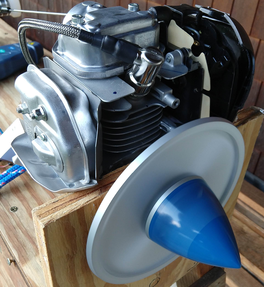GB engine and propeller testing has started!
One of my 3 engines is shown above during its mostly "stock" first run. Custom parts are being added one at a time so as to isolate potential problems.
The engine has been fitted with a Walbro WYL barrel-type carburetor with a small throat. This carburetor is somewhat sensitive to needle adjustments and requires a larger main jet. Although using a carb will not enable us to reach the lowest BSFC numbers possible, they should be good enough to set records. If initial powered flights and record attempts are successful, it is possible fuel injection will be added in the future.
In the future, I may increase the compression ratio. Option 1 is machining an offset hole for the piston pin. Option 2 is TIG welding on an additional ~1mm of piston height to increase the the compression ratio and efficiency of the engine. The success or failure of that experiment may be contingent on the exact alloy of the piston. It will be fixtured in water such that the side skirts will not be annealed. The final piston crown shape would be turned on my lathe.
Either way, with a piston stroke of only 26mm, it won't take much pin offset or filler rod!
One of my 3 engines is shown above during its mostly "stock" first run. Custom parts are being added one at a time so as to isolate potential problems.
The engine has been fitted with a Walbro WYL barrel-type carburetor with a small throat. This carburetor is somewhat sensitive to needle adjustments and requires a larger main jet. Although using a carb will not enable us to reach the lowest BSFC numbers possible, they should be good enough to set records. If initial powered flights and record attempts are successful, it is possible fuel injection will be added in the future.
In the future, I may increase the compression ratio. Option 1 is machining an offset hole for the piston pin. Option 2 is TIG welding on an additional ~1mm of piston height to increase the the compression ratio and efficiency of the engine. The success or failure of that experiment may be contingent on the exact alloy of the piston. It will be fixtured in water such that the side skirts will not be annealed. The final piston crown shape would be turned on my lathe.
Either way, with a piston stroke of only 26mm, it won't take much pin offset or filler rod!

 RSS Feed
RSS Feed
